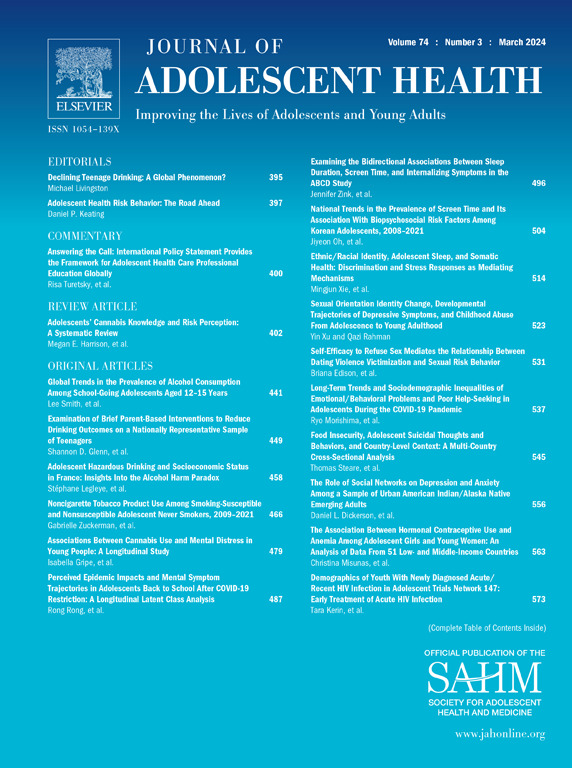Transitions in Gender Identity Among Youth: Trajectories of Perceptions of Family Acceptance
IF 5.5
2区 医学
Q1 PEDIATRICS
引用次数: 0
Abstract
Purpose
Family acceptance is a crucial protective factor for transgender and gender diverse (TGD) youth well-being. Few studies examine how families react to gender transitions by youth. This study aimed to examine whether families react differently when youth report different gender identities or when youth report gender-nonconforming expressions.
Methods
Data from 92 TGD youth from a community-based sample participated in up to 4 waves of surveys, 9 months apart (2012–2015). Three gender identity trajectories were identified: (1) youth who consistently identified as TGD (consistent TGD); (2) youth who were initially cisgender (CIS) but later identified as TGD (CIS→TGD); and (3) youth who identified as TGD but later identified as CIS (TGD→CIS). Patterns of family acceptance over time were analyzed using hierarchical linear modeling, including within-person (time-varying) and between-person associations.
Results
Youth who reported consistent TGD identities reported less family acceptance at baseline, and stable and low family acceptance across time; youth who initially identified as CIS and later as TGD reported a pattern of decreasing family acceptance (b = −0.41, p = .004). Current gender nonconformity (but not gender nonconformity in childhood) was associated with lower family acceptance (between-person level: b = −0.22, p = .005; within-person level: b = −0.12, p = .058).
Discussion
In a community-based sample of gender-diverse youth, family acceptance corresponds to gender identity and current gender expression (rather than gender expression earlier in childhood). Interventions should help families of TGD youth, particularly of those whose gender expression is nonconforming, understand gender-diverse identities.
青少年性别认同的转变:家庭接受认知的轨迹。
目的:家庭接纳是跨性别和性别多元化(TGD)青少年幸福的重要保护因素。很少有研究调查家庭对青少年性别转变的反应。本研究旨在探讨当青少年报告不同的性别认同或当青少年报告性别不一致的表达时,家庭的反应是否不同。方法:来自社区样本的92名TGD青年的数据参与了多达4波的调查,间隔9个月(2012-2015)。三种性别认同轨迹:(1)持续认同为TGD的青年(一致性TGD);(2)最初为顺性别(CIS)但后来被认定为TGD (CIS→TGD)的青少年;(3)先为TGD后为CIS的青年(TGD→CIS)。使用层次线性模型分析了家庭接受随时间变化的模式,包括人内(时变)和人与人之间的关联。结果:报告一致的TGD身份的青少年在基线时报告的家庭接受度较低,并且随着时间的推移,家庭接受度稳定且较低;最初确定为CIS和后来确定为TGD的青少年报告了家庭接受度下降的模式(b = -0.41, p = 0.004)。当前的性别不一致性(但不是儿童期的性别不一致性)与较低的家庭接受度相关(人与人之间水平:b = -0.22, p = 0.005;内部水平:b = -0.12, p = 0.058)。讨论:在以社区为基础的性别多样化青年样本中,家庭接受与性别认同和当前的性别表达(而不是童年早期的性别表达)相对应。干预措施应该帮助TGD青年的家庭,特别是那些性别表达不符合标准的家庭,理解性别多元化的身份认同。
本文章由计算机程序翻译,如有差异,请以英文原文为准。
求助全文
约1分钟内获得全文
求助全文
来源期刊

Journal of Adolescent Health
医学-公共卫生、环境卫生与职业卫生
CiteScore
10.40
自引率
3.90%
发文量
526
审稿时长
46 days
期刊介绍:
The Journal of Adolescent Health is a scientific publication dedicated to enhancing the health and well-being of adolescents and young adults. Our Journal covers a broad range of research topics, spanning from the basic biological and behavioral sciences to public health and policy. We welcome a variety of contributions, including original research papers, concise reports, literature reviews, clinical case reports, opinion pieces, and letters to the editor. We encourage professionals from diverse disciplines such as Anthropology, Education, Ethics, Global Health, Health Services Research, Law, Medicine, Mental and Behavioral Health, Nursing, Nutrition, Psychology, Public Health and Policy, Social Work, Sociology, and Youth Development to share their expertise and contribute to our mission of promoting adolescent health. Moreover, we value the voices of young individuals, family and community members, and healthcare professionals, and encourage them to submit poetry, personal narratives, images, and other creative works that provide unique insights into the experiences of adolescents and young adults. By combining scientific peer-reviewed research with creative expressions, our Journal aims to create a comprehensive understanding of the challenges and opportunities in adolescent and young adult health.
 求助内容:
求助内容: 应助结果提醒方式:
应助结果提醒方式:


